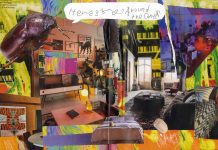Mitchell Squire’s exhibit opened at the Hunt Gallery on Feb. 11. That same day, Squire gave a lecture in the Winifred Moore Auditorium.
As Webster students and art enthusiasts stepped into the Hunt Gallery on Feb. 11, they encountered insightfully mysterious portraits of a masked man.
These images were the first portion of multidisciplinary artist Mitchell Squire’s exhibit, “Whatever it is I wish to see, I steal.”
The exhibition’s opening reception lasted from 5 to 7 p.m. It was preceded by Squire’s lecture in the Winifred Moore Auditorium at 1:30 p.m., where he summarized his career and elaborated on his “love-hate relationship” with photography.
Squire is a professor of architecture at Iowa State University. He has lectured at myriad institutions, such as the University of California, Berkeley; University of Tennessee; University of Minnesota and University of Michigan.
Hunt Gallery director Jeffrey Hughes, PhD, described Squire as “the artist who teaches architecture, or the architect who is an artist.”
Squire’s exhibition at the Hunt Gallery features a series of self-portraits and found images, which portray Squire’s relationship with photography and explore themes such as ageism, sexuality and racialization.

A series of self-portraits juxtaposed with historical images provides a multidimensional view of how Squire experienced and interpreted history. The exhibition’s titular piece, “Whatever it is I wish to see, I steal,” features a set of blurry self-portraits taken in front of a dusty, sunlit mirror.
“I’m focusing on the surface where the dust is somehow joining attention to that picture plane, if you will, that is otherwise thought to be nonexistent,” Squire said. “So it’s almost materializing something invisible that’s quite impactful in the use of the camera, for both good and not so good intentions.”
Through self-portraits that focus on the surface of a mirror rather than Squire himself – which creates what Squire calls a “dizzying effect” – he highlights the value of rawness in his artwork. He says he utilizes his self-image to express social reality.
“[Photography allows] me to show as much of me and how I want to be seen as I possibly can, to allow the audience to be confronted, as opposed to catering to their gaze,” he said.
In another one of the exhibition’s pieces, “These are the things for which you’re wishing,” viewers see eight gilded-framed photographs from the 1940s that Squire inherited. Through this display, Squire emphasizes the importance of preserving found objects.
“I have a love for things … I believe we have a relationship to them. And I also believe, more importantly, that the things we make, whether it’s a camera, whether it’s a car, whether it’s a boat or whatever, knows more about us – their maker – than the purposes for which they were made,” Squire said. “That would mean that a scissor knows more about us as humans than it knows about cutting a piece of paper.”

Hughes recalls the development of Squire’s exhibition, explaining its growth and the compromise that allowed it to exist.
“This exhibition has evolved over time. My association with Mitchell has evolved just from finding out about his work and finding out about him, following his work and corresponding until we were finally at a juncture. Then he goes, ‘So you wanted to see sculpture but I’m going to show photography.’ And I’m really pleased that he did,” Hughes said.
Hughes credited the Leigh Gerdine College of Fine Arts, the Missouri Arts Council, the Faculty Speakers’ Committee, his colleagues and supporters of Webster’s Department of Art, Design and Art History (DADAH) for the execution of the exhibition.
“Whatever it is I wish to see, I steal,” will be available for viewing at the Hunt Gallery until March 12.
Share this post
Molly Foust (she/her) spring 2023 Editor-In-Chief.




